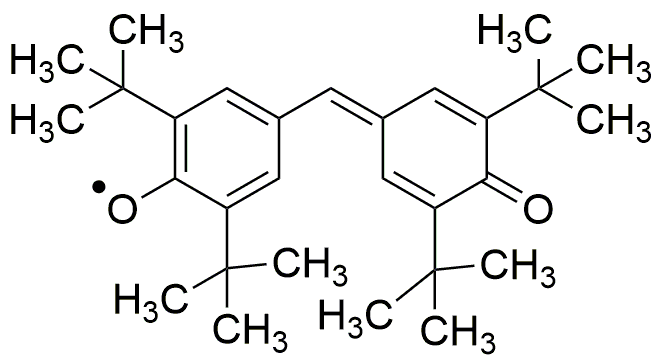Galvinoxyl, free radical is widely utilized in research focused on:
- Antioxidant Studies: This compound is frequently used in experiments to investigate its effectiveness as a radical scavenger, helping researchers understand how it can protect cells from oxidative stress.
- Polymer Stabilization: In the plastics industry, Galvinoxyl serves as a stabilizer for polymers, enhancing their resistance to thermal degradation and prolonging product life, which is crucial for manufacturers aiming for durability.
- Cosmetic Formulations: It is incorporated into skincare products for its antioxidant properties, providing consumers with formulations that help combat skin aging and protect against environmental damage.
- Food Preservation: The compound is also explored in food science for its potential to extend the shelf life of products by preventing oxidative spoilage, benefiting food manufacturers and consumers alike.
- Research on Free Radical Mechanisms: Galvinoxyl is a valuable tool in biochemical research, allowing scientists to study free radical mechanisms in various biological systems, which can lead to advancements in health and disease understanding.
General Information
Properties
Safety and Regulations
Applications
Galvinoxyl, free radical is widely utilized in research focused on:
- Antioxidant Studies: This compound is frequently used in experiments to investigate its effectiveness as a radical scavenger, helping researchers understand how it can protect cells from oxidative stress.
- Polymer Stabilization: In the plastics industry, Galvinoxyl serves as a stabilizer for polymers, enhancing their resistance to thermal degradation and prolonging product life, which is crucial for manufacturers aiming for durability.
- Cosmetic Formulations: It is incorporated into skincare products for its antioxidant properties, providing consumers with formulations that help combat skin aging and protect against environmental damage.
- Food Preservation: The compound is also explored in food science for its potential to extend the shelf life of products by preventing oxidative spoilage, benefiting food manufacturers and consumers alike.
- Research on Free Radical Mechanisms: Galvinoxyl is a valuable tool in biochemical research, allowing scientists to study free radical mechanisms in various biological systems, which can lead to advancements in health and disease understanding.
Documents
Safety Data Sheets (SDS)
The SDS provides comprehensive safety information on handling, storage, and disposal of the product.
Product Specification (PS)
The PS provides a comprehensive breakdown of the product’s properties, including chemical composition, physical state, purity, and storage requirements. It also details acceptable quality ranges and the product's intended applications.
Certificates of Analysis (COA)
Search for Certificates of Analysis (COA) by entering the products Lot Number. Lot and Batch Numbers can be found on a product’s label following the words ‘Lot’ or ‘Batch’.
*Catalog Number
*Lot Number
Certificates Of Origin (COO)
This COO confirms the country where the product was manufactured, and also details the materials and components used in it and whether it is derived from natural, synthetic, or other specific sources. This certificate may be required for customs, trade, and regulatory compliance.
*Catalog Number
*Lot Number
Safety Data Sheets (SDS)
The SDS provides comprehensive safety information on handling, storage, and disposal of the product.
DownloadProduct Specification (PS)
The PS provides a comprehensive breakdown of the product’s properties, including chemical composition, physical state, purity, and storage requirements. It also details acceptable quality ranges and the product's intended applications.
DownloadCertificates of Analysis (COA)
Search for Certificates of Analysis (COA) by entering the products Lot Number. Lot and Batch Numbers can be found on a product’s label following the words ‘Lot’ or ‘Batch’.
*Catalog Number
*Lot Number
Certificates Of Origin (COO)
This COO confirms the country where the product was manufactured, and also details the materials and components used in it and whether it is derived from natural, synthetic, or other specific sources. This certificate may be required for customs, trade, and regulatory compliance.


